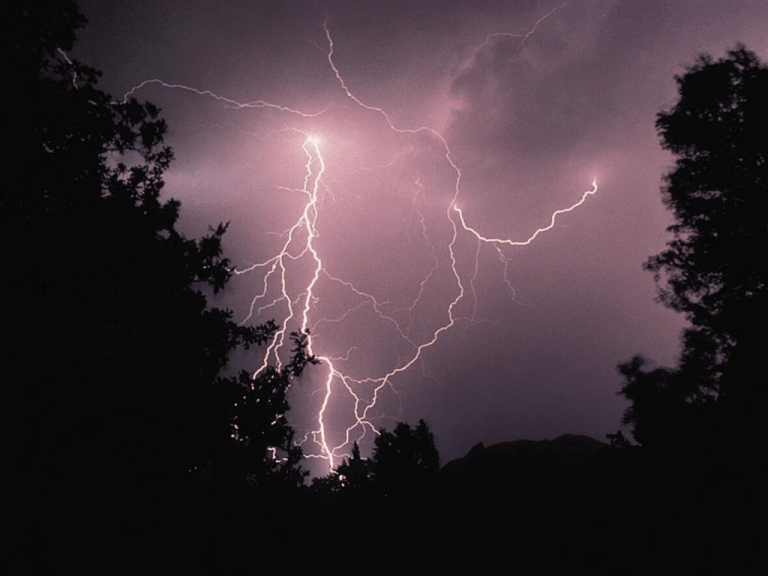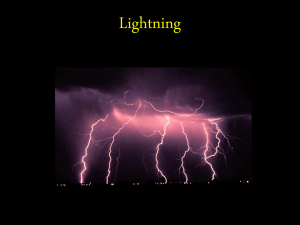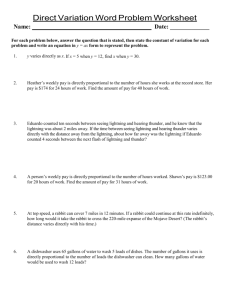Lightning i
advertisement

Lightning • Lightning is a discharge of electrical energy. • May occur: – Between cells in the same storm (Inter-cloud Lightning) – Within a cloud (Intra-cloud Lightning) – Cloud to Air – Cloud to Ground (CG) Intracloud (IC) vs. cloud to ground (CG) World map showing frequency of total lightning strikes (IC +CG), in flashes per km² per year. Lightning strikes most frequently in the Democratic Republic of the Congo IC vs. CG Number of Lightning Deaths in the United States Lightning Deaths in the United States Weighted by Population CG frequency in US Positive CGS Day vs. night Lightning Type “Popularity” - - - + + - - + + + + - + + + Negative Cloud-to-Ground (90 %) - - + - Positive Cloud-to-Ground (5 %) Lightning Type “Popularity” - + - + + - + + + + Positive Ground-to-Cloud (3 %) + - + - + - - Negative Ground-to-Cloud (2 %) The atmosphere normally has a voltage gradient of 100 volts/meter… … which may sound like a lot, but what happens when you stand one meter from a 110 volt outlet ? It takes about 1,000,000 volts/meter to cause a spark. That’s 10,000 volts per centimeter. Lightning • Air is a very good insulator. • To have lightning: – Need to have the charge centers very close to each other – Have very large differences in charge “strength” • In order to get lightning in a thunderstorm you need to separate large amounts of charge. How is this done? Charging by Induction Electrostatics One way to explain the charge separation Odd? An alternative explanation Graupel Method • During a collision between heavy graupel particles and lighter ice crystals: – Negative charge is transferred to the graupel – Positive charge is transferred to the ice crystals – Graupel falls to the bottom of the cloud bringing the negative charge with it – Ice crystals are transported to the upper levels of the thunderstorm Takahashi 1978 Charge Separation ++ +++ - - - -- - - -+ + + + + + The strong negative charge at the base of the thunderstorm induces a positive charge at the surface. + ▬ + Lightning (1) Lightning (2) Lightning (3) Lightning (4) Lightning (5) Lightning (6) The (CG) Lightning Stroke • The lightning stroke begins when the electric fields exceed breakdown voltage. • Initially streams of electrons surge from the cloud base toward the ground in steps of 50 to 100 m. • Start and stop steps as the stepped leader progresses toward ground. Stepped Leader • The stepped leader is: –Very Faint –Essentially invisible to the human eye –Produces an ionized channel that will allow for the flow of charge during the remainder of the lightning stroke. –Sometimes with branches Stepped Leader Stepped leader moving in ~50m steps. © 1969 Martin Uman -- From: Uman, Lightning The (CG) Lightning Stroke • When the stepped leader gets near the ground (~100 m or so): – Positive charge moves from the ground up toward the stepped leader -- these are called streamers. – The streamers may come from almost any pointed object on the ground: • Trees Antennas • Flagpoles Telephone Poles • Really Tall Towers Etc. Grass People Streamers A streamer rising from a part of the tree. The return stroke was created when the stepped leader met with a streamer from another part of the tree. © 1998 Oxford University Press -- From: MacGorman and Rust, The Electrical Nature of Storms Return Stroke • One of the streamers will meet the stepped leader -- not necessarily the one from the tallest object! • When they meet a pulse of energy flows up toward the cloud (along the ionized path) and toward the ground. • This luminous pulse of electrical energy is called the return stroke. • Occurs very fast -- we see it as a flash! Dart Leader • Often a second series of stepped flow of electrons moves from the cloud toward the ground. • Since the ionized channel already exists, the stepped flow is much faster. • This stepped flow is called the dart leader. • Dart leader does not have branches Return Stroke • When the dart leader connects with a streamer from the ground (usually along the same path) another return stroke moves toward the cloud and ground. • May get several sets of dart leader/return stroke pairs. • Appears as if the lightning “flashes.” Lightning Rods • Lightning rods act as locations where streamers can be launched toward descending stepped leaders. • It is better for the lightning rods to be struck, where the electrical energy can be safely transferred to ground, than the house. • The “cone of safety” is about 45o under the lightning rod. Lightning Rod Simulator Lightning striking the Empire State Building Thunder • Lightning is very hot (~30 000C). • Violently expanding air causes an audible shock wave. • Nearby Lightning – Thunder sounds like a “crack” or a loud bang. • Distant Lightning – Thunder sounds like a rumble. We are hearing the sound from different parts of the lightning channel. Thunder • How far is that lightning???? – Light travels much faster than sound. – Count the time between when you saw the flash and heard the thunder. • 5 seconds per mile • 3 seconds per km • No thunder? – Could be too far away – Sound could be “bent” by the atmosphere away from you. Thunder The man hears thunder from the bottom of the lightning channel in 6 seconds. He will continue to hear the thunder until sound from the top of the channel (2.8 km away) in 8.4 seconds. The short sound of thunder indicates a nearby strike. 2.8 km 2 km 2 km Assignment #6







